Public Affairs Alert:
| Path | Authored on | Image Path | Image Anchor | |||||
|---|---|---|---|---|---|---|---|---|
| New Fairfax County Policy Helps Empty Offices in Suburban Neighborhoods Convert to New Uses | The Fairfax County Board of Supervisors approved a change to the county’s land use plan to more easily allow empty office buildings in suburban neighborhoods to be converted into other uses. 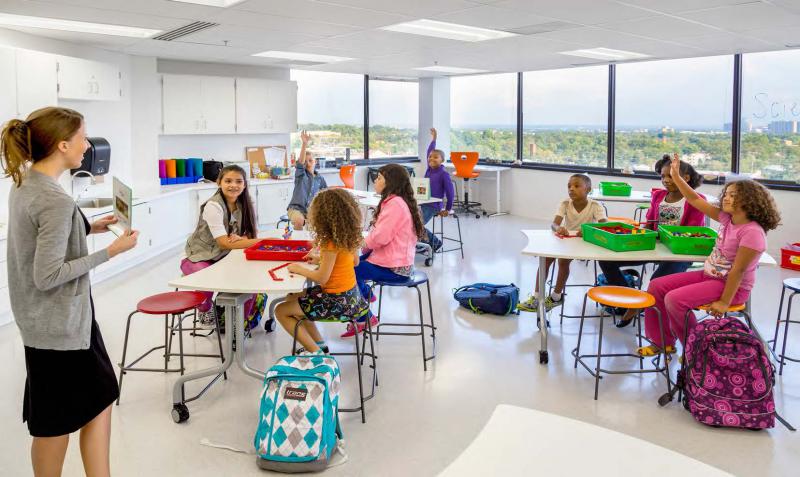
While suburban offices only make up 3.3 percent of the county’s vacant office space, this change could help these buildings find new life as apartments, live-work units, shops, hotels, schools, libraries, makerspaces and other light industrial or commercial uses. The board passed the policy update to the Comprehensive Plan at their May 1, 2018, meeting. The action follows a similar change approved last December for empty offices in areas planned for mixed-use or industrial areas. Policy Makes Office Conversion Easier and FasterOffices in suburban neighborhoods may now be turned into other uses without a site-specific change to the Comprehensive Plan if certain conditions are met. For example, these new uses must be compatible with surrounding development, offer more ways for pedestrians to access the building and consider impacts to schools and parks if new residences are considered. Most buildings proposed to be repurposed will need rezoning approval by the Board of Supervisors. This process incorporates opportunities for community input, including public hearings. County officials also retain the right to initiate a site-specific land use change to the plan for a reuse project. Fairfax's Suburban Office Vacancy RateWhile the county confronts 18 million square in office vacancies, most of this underused space can be found in the areas near Metro stations or other mixed use areas. Empty offices in suburban areas account for 607,000 square feet of this total. Looking at the data, the county’s planners found that 80 percent of suburban offices were fully occupied or had 10 percent or less vacancy. Only 25 offices accounted for almost 50 percent of the total vacant square footage. Office Conversion BoomOverall, there have been more office conversions in Northern Virginia during the last 2.5 years than the last 10 years combined, according to real estate services firm JLL. Last year, about 800,000 square feet were converted and another approximately 400,000 square feet have been announced for conversion so far this year. 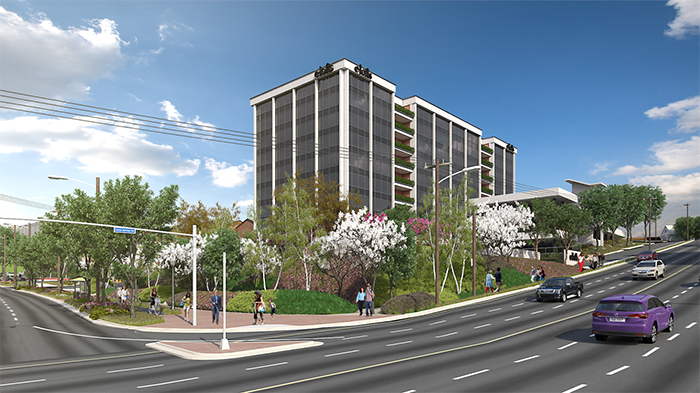
Offices built before 1980 have the lowest vacancy rate, 12.5 percent, says the Fairfax County Economic Development Authority. For suburban offices, however, most of the vacancies are found in buildings constructed in the 1980s or earlier. Of the 25 offices that make up half of the square footage in vacancies, 21 are from the 1980s and 70s. In general, suburban offices are more likely to be fully leased since they are smaller buildings that often serve small businesses like doctors, travel agents and real estate brokers. Offices with vacancies rates of 10 percent or less are unlikely to be converted to other uses, say county planners. This finding comes from conversations with building owners and developers. # # #
|

|
Read full article | May 3, 2018 | May 3, 2018 | /publicaffairs/sites/publicaffairs/files/Assets/images/baileys-elementary-classroom.jpg | 0 | Top |
| Learn About Proposed Zoning Changes That May Affect Your Neighborhood at the 2018 Zoning Open Houses | Community gardens, farmers markets, craft manufacturing, signs, assisted living communities, a Come to one of three open houses in May and June where you can learn more about how these proposed zoning changes may affect you and your neighborhood. They will take place at 7 p.m. in the cafeteria of these schools:
At the open house, you’ll be able to:
Every year, the Board of Supervisors adopts a work program for zoning ordinance amendments, and this program guides which zoning changes are considered. The 2017 program contains 39 proposed amendments that include:
Public input is key to shaping proposed zoning amendments that ultimately must be approved by the Board of Supervisors. Residents are encouraged to offer their thoughts early in the process, and the Planning Commission and Board of Supervisors also hold public hearings on proposed amendments. For questions about the scheduled open houses, reasonable ADA accommodations or to offer feedback on proposed amendments, contact the Zoning Administration Division by email at or call 703-324-1314, TTY 711. # # # |

|
Read full article | May 2, 2018 | May 2, 2018 | /publicaffairs/sites/publicaffairs/files/Assets/images/famers-market-strawberries.jpg | 0 | Top |
| Fairfax County Board of Supervisors Approves Scotts Run South Development in Tysons |
Almost two-times the size of its other development in Tysons— Arbor Row—CityLine Partners’ Scotts Run South project will add more than 6.6 million square feet of mixed use development near the future McLean Metro station. This project will erect 17 new buildings, including office, residential, retail and a hotel. Scotts Run South will replace much of the existing West*Gate office park. The majority of Scotts Run will be within a quarter mile from the McLean station, the easternmost rail stop in Tysons. The more than 30-acre project is separated by Scotts Run Park. Most of the development sits to the east of the stream valley park on a 23-acre site, along Route 123 near the intersection of Colshire Drive. The plan calls for 13 new buildings—six office, six residential, and one hotel. These account for more than 5.1 million square feet of the total development. To the west of the park, the development covers two parcels, totaling 6.9 acres, along both sides of Old Meadow Road from Route 123 to Colshire Meadow Road. This portion of Scotts Run includes four buildings—one apartment and three high-rise office buildings up to 350 feet tall. While most of the development will be built over time as market conditions allow, CityLine submitted two final development plans, which would allow construction to begin quickly. These plans include two residential buildings with up to 440 units located between Chain Bridge Road and Anderson Road. Also included is a 225-foot, 340,000 square foot office building on 2.94 acres associated with the MITRE office park. The plan incorporates many features that move forward Fairfax County’s goal to turn Tysons into a walkable, environmentally friendly, 24/7 urban center, including:
CityLine also has committed to building a 15,000 square foot, free-standing fire station off-site on Old Meadow Lane. Based on county projections, a new station will be needed in this part of Tysons within seven years, and the developer must provide the new station no later December 31, 2020. Scotts Run South is one of the 18 major redevelopment applications for Tysons. Collectively, these applications propose more than 36 million square feet of new development. If all approved, these projects will generate an estimated 29,000 new residents and 58,000 new employees during the next 20 years or longer. Under the county’s transformation plan, Tysons will become a green, walkable urban center. By 2050, Tysons will be home to up to 100,000 residents and 200,000 jobs. # # # |
Read full article | April 9, 2013 | April 9, 2013 | 0 | |||
| Learn about Zoning Trends at Two Community Meetings for Fairfax County’s Zoning Modernization Project | Fairfax County will hold community meetings on May 8 and 10 as part of its overall effort to modernize its zoning ordinance, called zMOD. zMOD aims to make the county’s 1970s-era zoning ordinance easier to use, and the project supports the county’s strategic plan to grow and diversify its economy. The meetings will provide more context to the zMOD project and will offer the community opportunities to provide feedback. At the meetings, the county’s consultant, Clarion Associates, will present its proposed restructuring of the ordinance to make it more user friendly. They also will present national trends in zoning ordinances, focusing on how the regulations are evolving to address new land uses while still ensuring residential neighborhood compatibility. The May 8 meeting begins at 7 p.m. in the cafeteria at George Marshall High School, 7731 Leesburg Pike, Falls Church. On May 10, the meeting starts at 7 p.m. at the South County Center, Rooms A and B, 8350 Richmond Highway, Alexandria. In addition to the two community meetings, Clarion will discuss this information with the Fairfax County Planning Commission on May 9 at 7:30 p.m. at the Fairfax County Government Center Board Auditorium. This public meeting will be televised live on Channel 16. Because this is a work session for the Planning Commission, there is no opportunity for public testimony or comment at this meeting. The first community meeting for the project was held in January. To learn more, watch the video from this meeting and review the presentation. For more information or reasonable ADA accommodations, contact the Fairfax County Office of Community Revitalization at 703-324-9300, TTY 711. # # # |
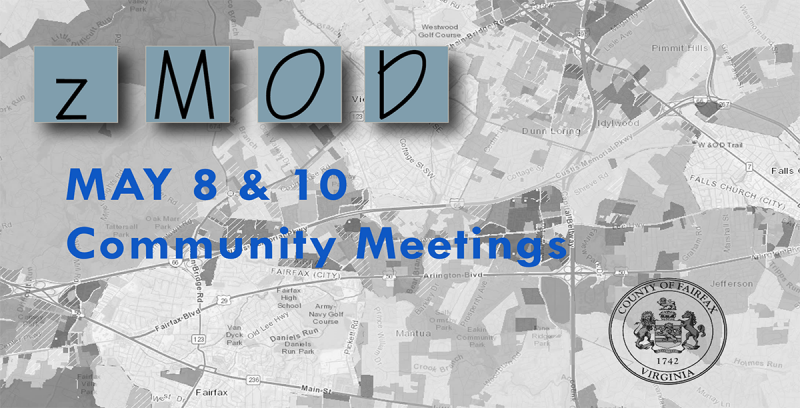
|
Read full article | April 23, 2018 | April 23, 2018 | /publicaffairs/sites/publicaffairs/files/Assets/images/zmod-may-meetings.png | 0 | Top |
| Bettina Lawton Appointed to Fairfax County Electoral Board |
Bettina M. Lawton was recently appointed by the Fairfax Circuit Court and sworn in as a member of the Fairfax County Electoral Board. She replaces Seth Stark who resigned effective April 10 after serving on the Electoral Board from 2011. In each county and city in Virginia, a three-member Electoral Board is responsible for the proper and orderly conduct of all elections held in their locality. This includes preparation of ballots, administration of absentee ballot provisions, the conduct of the election and ascertaining of results of the election. The two other members of the Fairfax County Electoral Board are Katherine K. Hanley and Stephen M. Hunt. Lawton is vice chair of the Fairfax-Falls Church Community Services Board, president of the Auxiliary to the Veterans of Foreign War Blue and Gray Post 8469 and a reserve deputy sheriff for the Fairfax County Sheriff's Office. In addition, she is a member of WealthCounsel, a nationwide organization of small firm and solo estate planning attorneys committed to practice excellence. Lawton is a member of the Fairfax Bar Association, the American Bar Association, the Virginia State Bar and the D.C. Bar and their respective sections for wills, trusts and estate practitioners. She is licensed to practice law in Washington, D.C., New York and Virginia and before the U.S. Supreme Court. Lawton is a graduate of Georgetown University Law Center and Siena College. Additional Information: ### |
Read full article | April 18, 2018 | April 18, 2018 | 0 | |||
| BLVD at Reston Station Demonstrates the Economic Success of Public-Private Partnership for Fairfax County | Called BLVD, a new 21-story, luxury apartment building that rises up next to what’s currently the last stop on the Silver Line opened its doors on Tuesday. Fairfax officials hailed the event because it shows how the county’s economic strategy is delivering dividends. This building, which is the first in a larger development at the site, has generated more than $110 million in increased property value so far. The taxable value climbed from $15,416,610 to $125,614,080, and these values are expected to go even higher when the development is complete. The project resulted from a public-private partnership with developer Comstock which is building on top of county-owned land. Fairfax is turning to these partnerships as a key tool in their efforts to grow and diversify the economy. County leaders point to 17 other similar projects that are intended to grow the tax base, spur revitalization or deliver services. "When the public and private sectors partner on big projects like this one, businesses and the county benefit from new revenue, and residents benefit from new services and opportunities,” said Fairfax County Board of Supervisors Chairman Sharon Bulova. “This project demonstrates our economic strategy is working. It’s growing and diversifying the county’s economy, including our tax base.” BLVD is one of eight high rises that will make up Reston Station. This mixed use development will bring up to 1.3 million square feet in housing, offices, retail, and a hotel with direct access to the Silver Line. It’s located between Reston Station Boulevard and Wiehle Avenue, just north of the Wiehle-Reston East Metro station. A walkway links the station to the project’s civic plaza, and the development largely sits on top of the county’s underground garage for rail commuters. Fairfax County owns about nine acres that make up the more than 12-acre development. Five years ago, the county sought a partner to help build the public garage to serve the station while maximizing he economic return on its land. Under the partnership, Comstock built the 2,300-space garage for the county, and the developer leases the county land where five of its buildings will spring up. The deal delivered an important public facility to serve the new rail line. It also creates the kind of mixed-use, transit oriented development that county leaders want to see more of in Fairfax. County officials point to this project as prime example of its Economic Success Plan in action, using multiple tactics. It calls for creating the urban, walkable neighborhoods near transit that everyone from millennials to baby boomers want to live in. The plan also seeks to use public-private partnerships, like this joint-venture, to maximize the return on investment potential for all county assets, including land and facilities. The county also seeks to leverage partnership opportunities with both private and public partners to construct and operate infrastructure and facilities. The county is also pursuing more affordable housing as a way to boost economic growth. BLVD’s 448 apartments include 88 workforce units—or about 20 percent of the building’s total. The apartment building incorporates about 8,500 square feet of retail into its ground floor. Amenities include a rooftop pool and terrace, a fully equipped fitness center, yoga room, state-of-the-art business center, secure garage parking, and numerous outdoor amenities including cooking stations, outdoor movie screening area and a mid-level, south-facing terrace. Reston Station is just one the county’s public-private partnerships, and other similar projects include Reston Town Center North, Innovation Station, and Liberty at Laurel Hill. # # # |
Read full article | March 6, 2016 | March 6, 2016 | 0 | |||
| Fairfax County to Present Embark Richmond Highway at ITE Conference | Fairfax County will present its work on Embark Richmond Highway at the prestigious Institute of Transportation Engineers (ITE) Mid-Colonial District Annual Conference on April 16 in Philadelphia. The county’s transportation and land use planners will discuss the ambitious effort to transform the 7.5-mile corridor to support multi-modal improvements that include a bus rapid transit (BRT) system, increased mobility and revitalization. Tom Burke from the Fairfax County Department of Transportation and Joanne Fiebe from the Fairfax County Office of Community Revitalization will present. 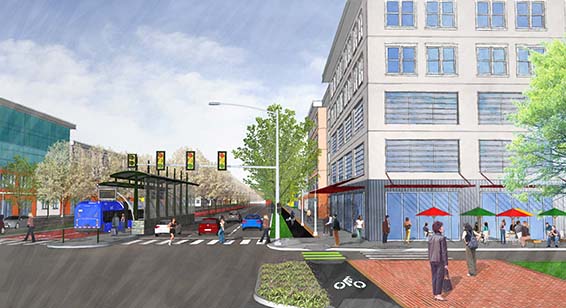
Embark includes the overall effort to revamp the corridor’s land use plan, widen the highway to six lanes along the entire corridor, provide continuous sidewalk and bicycle facilities, build a BRT system, and incorporate policy language for an eventual two-stop extension of Metro’s Yellow Line. Fairfax received a $400,000 grant from the Federal Transit Administration, with a $200,000 match from Virginia Department of Rail & Public Transportation, to help develop urban design standards and refined grids of streets. The county was one of only 16 jurisdictions to receive the FTA’s Pilot Program for Transit-Oriented Development Planning grant in 2016. Last month, the Fairfax County Board of Supervisors approved the sweeping new land use plan that was the first major step needed to build the future BRT system. Overall, the land use plan supports transit and greater mobility, including:
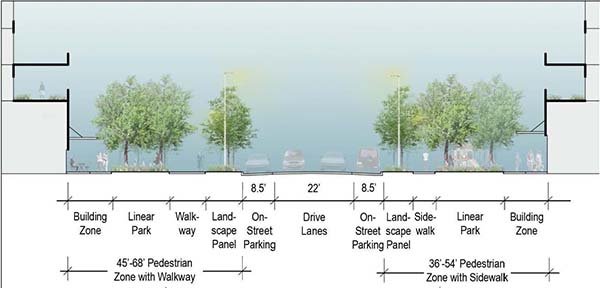
The planning and design for the nine-station, BRT system have begun. It will operate mainly in the median from the Huntington Metrorail Station to Fort Belvoir. The BRT will initially be built in two phases, with the first connecting the Huntington Metro to Hybla Valley. The environmental analyses and preliminary design for this first phase are currently anticipated to be completed by the end of 2019. Founded in 1930, the Institute of Transportation Engineers is an international membership association of transportation professionals, including engineers, planners, consultants, educators, technologists, and researchers. For more information, contact the Fairfax County Department of Transportation at 703-877-5602, TTY 711. # # #
|

|
Read full article | April 3, 2018 | April 3, 2018 | /publicaffairs/sites/publicaffairs/files/Assets/images/embark-brt-rendering.jpg | 0 | Top |
| Planning Commission Approves Proposal to Allow Conversion of Empty Offices in Suburban Neighborhoods | The Fairfax County Planning Commission recommended approval for a proposal to allow empty office buildings in suburban neighborhoods to be converted into other uses. These partially vacant or empty offices could find new life as apartments, live-work units, shops, hotels, schools, libraries, makerspaces and other light industrial or commercial uses. 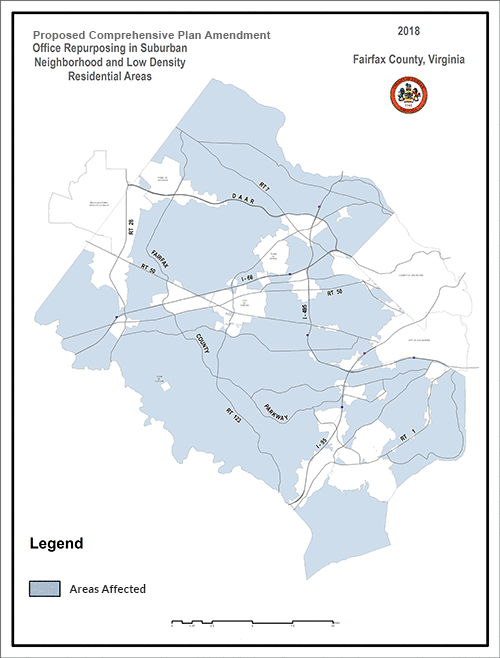
Officials are considering this update to the county’s land use plan, known as the Comprehensive Plan, following a similar change approved last year for empty offices in areas planned for mixed use or industrial development. The proposal would allow offices in suburban neighborhoods to be turned into other uses without a site-specific change to the Comprehensive Plan. Most buildings proposed to be repurposed will need rezoning approval by the board. This process incorporates opportunities for community input, including public hearings. County officials also retain the right to require a reuse project to go through a site-specific land use change. The proposed policy also sets seven conditions for buildings to be eligible for reuse. For example, these new uses must be compatible with surrounding development, offer more ways for pedestrians to access the building and consider impacts to schools and parks if new residences are considered. Suburban Office Vacancy RateWhile the county confronts 18 million square in office vacancies, most of this underused space can be found in the areas near Metro stations or other mixed use areas. Empty offices in suburban areas make up about 3.3 percent—or 607,000 square feet—of the 18 million square foot total. Looking at the data, the county’s planners found that 80 percent of suburban offices were fully occupied or less than 10 percent vacant. Only 25 offices accounted for almost 50 percent of the total vacant square footage. In general, suburban offices are more likely to be fully leased since they are smaller buildings that also often serve small businesses like doctors, travel agents and real estate brokers. Offices with vacancies rates of 10 percent or less are unlikely to be converted to other uses, say county planners. This finding comes from conversations with building owners and developers. Next StepsThe proposal must ultimately be approved by the Board of Supervisors which is currently scheduled to hold a public hearing on May 1. # # # |
Read full article | March 26, 2018 | March 26, 2018 | 0 | |||
| Fairfax County Holds Smart Cities Readiness Workshop to Harness Innovative Tech | Streetlights that act like Fitbits, collecting and reporting data on air quality, parking spaces or pedestrian and vehicle traffic. Traffic lights that adjust their timing based on real-time, road conditions to keep cars moving. These aren’t science fiction technologies – they’re things that smart cities around the world are putting to use today. To advance its ongoing efforts to use innovative tech, data and analytics to improve its services, Fairfax County held a workshop with the Smart Cities Council on March 19. “Fairfax County was so pleased to host the Smart Cities Readiness Workshop,” said Fairfax County Chairman Sharon Bulova. “We are excited about opportunities to further harness technology to improve health, increase connectivity and assure an awesome quality of life for our residents.” The event brought together more than 200 experts from county agencies, public schools, utilities, regional transportation agencies, universities and nonprofits. The effort aimed to help the county begin drawing a conceptual roadmap to becoming a smart county. “Now what Fairfax County has already shown is that it’s a winner,” said Philip Bane, managing director of the Smart Cities Council. “It has champions. It has leadership that is interested in making this transformation.” Fairfax is already further ahead of other communities in North America, according to Bane. The council helps governments around the world, and it offers training, insights and best practices collected from its global activities. Workshop FocusAt the county’s workshop, the council convened some of its experts to offer case studies on what others are doing across the globe, and participants collaborated to sketch out ideas and actions that the county can implement. The workshop concentrated on three areas:
The focus on health looked at the county and public school’s existing efforts to combat childhood obesity. One-third of county kindergartners are overweight or obese, and the statistics are even higher among African American and Hispanic children, among the worst in the nation. “Some of the things we’re thinking about are data analytics,” said Eta Davis, economic initiatives coordinator for Fairfax county. “How can we use this amazing power of data to help us focus our efforts in fighting obesity.” Workshop attendees also considered how to improve transportation. “We’re also thinking about the mobility ecosystem,” Davis said. “How can we use the various technologies available to address traffic congestion issues.” Northern Virginia faces three major transportation issues: congestion, safety and mobility, that is providing new ways to get around including as people age. The third focus area was infrastructure. There are many possible smart technologies that could be applied. The county, for example, is looking at pilot with Dominion to install sensor on streetlights to collect data. Technology could also make operations more efficient when it comes to monitoring and maintaining the county’s 32,000 miles of sewer lines. They are inspected with closed circuit cameras today—but technology exists that would allow the county to do in a week what it now takes a year to do. Delivering a Higher Quality of LifeBy employing new technologies, the county can become an even more vibrant, prosperous, green place to live, work and play. This is the ultimate goal for smart cities and counties—delivering a high quality of life that benefits everyone. “Smart cities at its most basic are the use of technology to deliver livability, workability and sustainability,” Bane said. They deploy intelligent technology like sensors to collect data, communicate it back and analyze it. This data can provide real-time intelligence about what’s happening, such as traffic conditions. The information can be used to make changes in real time or provide predictive analytics. Growing the Innovation EcosystemFairfax County’s foray into smart cities technology is a direct result of its strategic plan to grow and diversify its economy. The workshop supports the county’s efforts to become an innovation hub and encourage more entrepreneurship and startups. “It’s also a lot about growing our innovation ecosystem,” said Davis. “We have a lot of smart cities industries here in Fairfax County, so we want to make connections between those companies, government, nonprofits.” # # # |
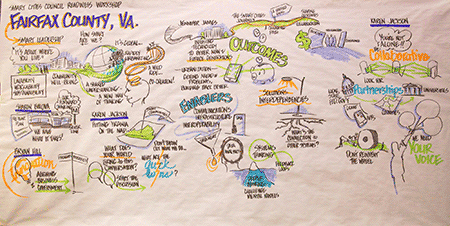
|
Read full article | March 21, 2018 | March 21, 2018 | /publicaffairs/sites/publicaffairs/files/Assets/images/smart-cities-workshop-drawing-small.gif | 0 | Top |
| Fairfax County to Hold Public Hearings on Proposed Zoning Rules for Short-Term Lodging | Today, the Fairfax County Board of Supervisors authorized public hearings for proposed new zoning rules on short-term lodgings, such as those offered through Airbnb, VRBO and Flipkey. The Planning Commission is scheduled to hold its hearing on May 3, and the board will hold its own hearing on June 19. These dates are subject to change, however. The county has been working on the new zoning rules over the past year, following a 2017 state law that allows local governments to regulate these kinds of short-term uses. Zoning officials say the proposed rules attempt to strike a balance between allowing these rentals, which are popular in today’s sharing economy, and addressing neighborhood concerns. Except for bed-and breakfasts and hotels, Fairfax’s zoning rules currently don’t permit homeowners to allow transient occupancy in their homes, yet there are an estimated 1,500 active Airbnb listings in Fairfax County. Transient occupancy — more commonly called short term rentals or lodging —are defined as rentals of fewer than 30 days. The regulations, if ultimately enacted, wouldn’t bar individual homeowners or community associations from prohibiting short-term lodgings, officials say. Proposed RulesAs proposed, the regulations would only allow property owners or renters to offer their primary residence as short-term lodging. This limitation is to prevent businesses from operating multiple, full-time rentals, like a hotel or motel, in residential neighborhoods. Guests would be limited to six adults, and the lodgers must all be associated with the same rental contract to prevent multiple rentals of a property at the same time. To protect neighborhoods, properties may not be rented for events or commercial purposes like parties, weddings or fundraisers. The proposal also caps the maximum number of nights short-term lodgings may be rented out. The rules would allow for up to 180 calendar days, but zoning officials are recommending a 90-night limit or 25 percent of a year. The Planning Commission and the board will also consider whether property owners or renters must be present in their home or apartment when it is used as a short-term lodging. Despite the number of short-term rentals allegedly operating to date, the county has received 54 complaints—or less than 1 percent of the estimated 1,500 Airbnb rentals listed within the county. County officials acknowledge that enforcement could be a challenge even with the new rules, particularly when it comes to the limit on number of nights and guests. The rules include provisions that will help with enforcement, however. For example, short-term operators must get a permit that can be revoked, and properties must be made available for inspection by county code enforcement inspectors upon request. Financial ImpactShort-term lodging operators also must pay transient occupancy taxes. County leaders calculate that these rentals could generate $428,268 in transit occupancy taxes a year. Of this amount, $249,823 would go to the county’s coffers, and the remaining amount would be used to support tourism and regional transportation as required by state law. Rules Created with Extensive Public InputZoning officials engaged in extensive public input to develop the proposed rules. They received more than 7,600 responses to an online survey, held four community meetings across the county and met with individual homeowners and civic groups, tourism professionals, real estate agents and representatives from the short-term lodging and hotel industry. County staff also participated in a workgroup with other local jurisdictions that are considering or have adopted regulations, including Arlington, Alexandria and Loudoun. In a separate and future proposal, Fairfax County is also considering whether to create zoning rules for commercially managed apartment buildings that offer short term lodging. # # # |

|
Read full article | March 20, 2018 | March 20, 2018 | /publicaffairs/sites/publicaffairs/files/Assets/images/airbnb-check-in.jpg | 0 | Top |